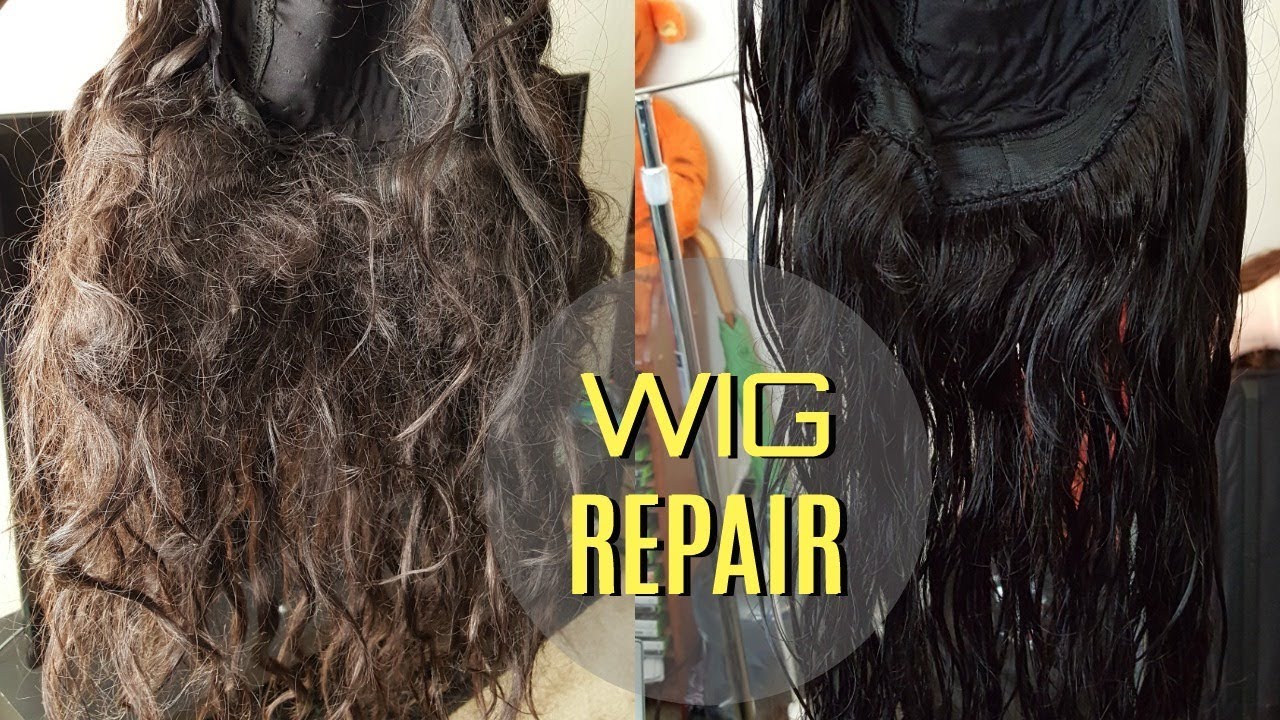So, you’ve invested in a beautiful human hair wig and want to make sure it stays tangle-free for as long as possible. Well, you’re in the right place! In this article, we’re going to delve into the world of human hair wigs and discuss some tips and tricks to help you keep your wig from tangling. Trust me, by the end of this article, you’ll be armed with all the knowledge you need to keep your wig looking smooth and beautiful.
First things first, let’s talk about brushing. One of the most important steps in preventing tangling is to brush your human hair wig regularly. Use a wide-tooth comb or a wig brush specifically designed for human hair wigs. Start from the ends and work your way up to the roots, gently detangling any knots or tangles. Remember to be gentle to avoid damaging the hair and always brush in a downward motion to prevent further tangling.
Another crucial step in preventing tangling is proper storage. When you’re not wearing your wig, make sure to store it in a cool, dry place. Avoid storing it in a cramped space where it can get easily tangled with other items. It’s also a good idea to invest in a wig stand or wig hanger to help maintain the shape and prevent tangling while it’s not being worn.
Lastly, proper washing and conditioning are essential. Use a gentle shampoo and conditioner specifically formulated for human hair wigs. Avoid harsh chemicals and hot water as they can damage the hair and contribute to tangling. After washing, make sure to thoroughly rinse out all the product to prevent residue buildup that can cause tangling. Use a leave-in conditioner or a detangling spray to keep the hair hydrated and smooth.
And there you have it! By regularly brushing, storing properly, and using the right products, you can keep your human hair wig tangle-free for longer. Remember, a little bit of care and maintenance goes a long way in preserving the natural beauty of your wig. So go ahead and rock that flawless hairstyle with confidence! Tangling is a common issue faced by wig wearers, regardless of the type of wig they choose. However, with the right care and maintenance, you can prevent tangling and keep your human hair wig looking beautiful and tangle-free. Here are some tips and techniques to help you keep your human hair wig from tangling:

Preventive Care
Brush the wig before and after each use
Brushing your wig before and after each use helps to prevent tangles from forming. Use a brush specifically designed for wigs, or a wide-tooth comb, to gently remove any knots or tangles. Start at the ends of the hair and work your way up to the roots, being careful not to pull or tug on the hair too much.
Use a wide-tooth comb or brush designed for wigs
Using the right tools is essential for maintaining the integrity of your human hair wig. Avoid using regular brushes or combs, as they can cause damage to the hair shafts and lead to tangling. Opt for a wide-tooth comb or a brush designed specifically for wigs, as they are designed to be gentle and prevent unnecessary pulling or breakage.
Avoid excessive heat styling or use heat protectant products
While human hair wigs can withstand heat styling, excessive use of heat can lead to damage and tangling. Limit the use of hot styling tools such as straighteners, curling irons, and hairdryers, or use them on a lower temperature setting. Additionally, always use a heat protectant product before applying heat to your wig, as this can help to minimize damage and tangling.
Protect the wig from harsh weather conditions
Harsh weather conditions such as strong winds, rain, and extreme heat or cold can cause tangling in your human hair wig. Whenever possible, protect your wig from these elements by wearing a hat or a scarf. If you do find yourself caught in bad weather, take the time to brush through your wig and detangle any knots as soon as possible.
Store the wig properly when not in use
Proper storage is crucial for keeping your human hair wig tangle-free. When you’re not wearing your wig, store it in a clean, dry, and dust-free area. Avoid folding or creasing the wig, as this can lead to tangles. Instead, place the wig on a wig stand or a mannequin head to help maintain its shape and prevent tangling.
Washing and Conditioning
Use a gentle shampoo for human hair wigs
When washing your human hair wig, use a gentle shampoo specifically formulated for wigs. Regular shampoos can be too harsh and strip the hair of its natural oils, leading to dryness, frizz, and tangling. Gently massage the shampoo into the wig, focusing on the roots. Rinse thoroughly with lukewarm water to remove all traces of shampoo.
Avoid using hot water to wash the wig
Hot water can be damaging to human hair wigs, causing them to become dry and brittle. Use lukewarm water instead when washing your wig. The temperature of the water should be comfortable to the touch, but not too hot. This will help to preserve the natural moisture and prevent tangling.
Condition the wig to keep it moisturized and detangled
After washing, it’s essential to condition your human hair wig to restore moisture and keep it detangled. Use a conditioner specially formulated for wigs, apply it evenly from root to tip, and leave it on for a few minutes. Rinse thoroughly to remove any residue. Conditioning helps to keep the hair soft, smooth, and less prone to tangling.
Rinse the wig thoroughly to remove all product residue
After shampooing and conditioning, make sure to rinse your wig thoroughly. Leftover product residue can weigh down the hair and contribute to tangling. Use lukewarm water and continue rinsing until the water runs clear. This ensures that no product is left behind, leaving your wig clean and ready to wear.
Avoid rubbing or twisting the wig while washing
When washing your human hair wig, avoid rubbing or twisting the hair, as this can lead to tangling and damage the hair shafts. Instead, gently squeeze out excess water using a towel or your hands. Pat the wig dry gently without rubbing, and allow it to air dry on a wig stand or mannequin head to maintain its shape and prevent tangling.
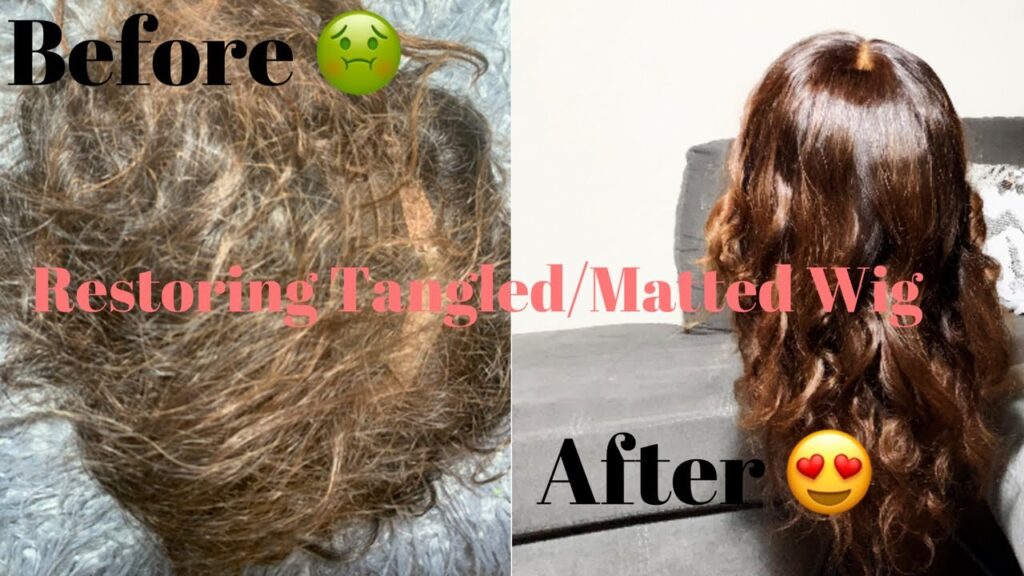
Detangling Techniques
Use a detangling spray or serum before combing the wig
Before combing or brushing your human hair wig, apply a small amount of detangling spray or serum to the hair. This helps to reduce friction and makes the hair easier to comb through. Spray the product evenly throughout the wig, focusing on areas that are prone to tangling. Allow the product to sit for a few minutes before combing.
Start detangling from the ends and work your way up
When detangling your wig, always start from the ends and work your way up towards the roots. This helps to minimize breakage and make the process easier. Hold the hair gently at the roots to provide support and prevent unnecessary pulling or tugging.
Use your fingers or a wide-tooth comb to gently detangle
When detangling your human hair wig, use your fingers or a wide-tooth comb to gently work through any knots or tangles. Start from the ends and work your way up, using smooth and slow strokes. Be patient and gentle, as rough handling can cause breakage and further tangles.
Avoid pulling or tugging on knots
It’s important to avoid pulling or tugging on knots when detangling your human hair wig, as this can lead to breakage and damage the hair fibers. Instead, use gentle and light pressure when working through knots, using your fingers or a wide-tooth comb. Take your time and be patient, as rushing through the process can cause more tangles.
Consider using a wig stand or mannequin head for easier detangling
Detangling a human hair wig can be made easier by placing it on a wig stand or a mannequin head. This provides stability and support, allowing you to detangle the hair more effectively without putting unnecessary strain on the wig. It also allows you to see the entire wig and work through the hair more evenly.
Styling Tips
Avoid excessive styling and manipulation
While human hair wigs offer endless styling possibilities, excessive styling and manipulation can lead to tangling and damage. Limit the use of heat styling tools and avoid constant restyling. Instead, find a style that suits you and stick with it for a while, allowing the hair to rest and minimize the risk of tangling.
Use a heat protectant spray when using styling tools
If you do choose to style your human hair wig using heat tools, always use a heat protectant spray before applying heat. This helps to minimize damage and maintain the integrity of the hair. Spray the heat protectant evenly throughout the wig, focusing on the areas that will be exposed to heat.
Try different hairstyles to distribute tension evenly
To prevent tangling, it’s a good idea to try different hairstyles from time to time. Wearing the wig in the same style every day can cause tension and stress on specific areas, leading to tangling. Experiment with updos, braids, and ponytails to distribute the tension evenly and reduce the risk of tangling.
Avoid using heavy styling products that can weigh down the wig
While styling products can enhance the look of your human hair wig, it is important to avoid using heavy products that can weigh down the hair and contribute to tangling. Opt for lightweight and water-based products, such as mousse or sprays, that provide hold without leaving a sticky residue.
Consult a professional stylist for intricate styling
If you’re looking to achieve a more intricate or elaborate hairstyle with your human hair wig, it’s best to consult a professional stylist. They have the expertise and experience to create complex styles without causing damage or tangling. A professional stylist can also provide guidance on how to maintain the style and prevent tangling between salon visits.
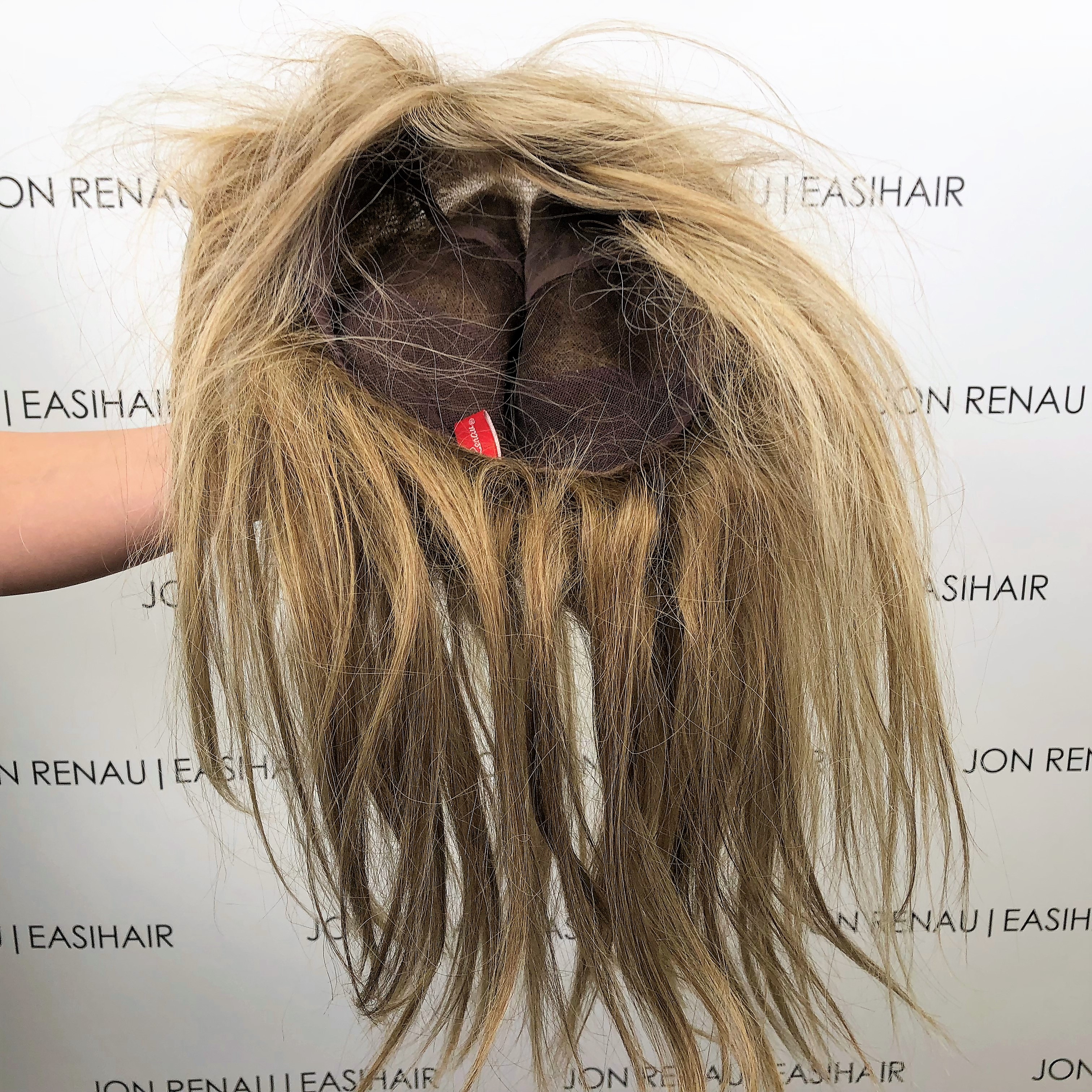
Sleeping and Bedtime Care
Brush and detangle the wig before going to bed
Before going to bed, make sure to brush and detangle your human hair wig. This helps to remove any knots or tangles that may have formed throughout the day, preventing them from becoming more severe overnight. Use a wide-tooth comb or your fingers to gently work through the hair, starting from the ends and working your way up.
Consider wrapping the wig in a silk or satin scarf or bonnet
To further protect your human hair wig from tangling while you sleep, consider wrapping it in a silk or satin scarf or bonnet. These fabrics are smooth and gentle on the hair, reducing friction and minimizing the risk of tangling. Secure the scarf or bonnet with a loose knot to keep the wig in place.
Use a silk or satin pillowcase to reduce friction
If you prefer not to wrap your wig in a scarf or bonnet, another option is to use a silk or satin pillowcase. These materials are much smoother than cotton, reducing friction and allowing the hair to glide freely. This can help to prevent tangling and maintain the integrity of your human hair wig.
Avoid sleeping on wet or damp hair
Sleeping on wet or damp hair can lead to tangling, as the hair is more vulnerable to friction when it’s wet. Allow your human hair wig to air dry completely before going to bed, or use a hairdryer on a low setting to speed up the drying process. Sleeping on dry hair helps to reduce the risk of tangling.
Secure the wig with clips or pins to prevent tangling during sleep
If your human hair wig tends to move around or shift during sleep, consider securing it in place with clips or pins. This helps to prevent tangling and keeps the wig in position throughout the night. Make sure to use gentle clips or pins that won’t damage the wig or cause discomfort.
Maintenance Tips
Regularly trim the ends to prevent split ends and tangling
Regular trimming is essential for maintaining the health and appearance of your human hair wig. Just like natural hair, the ends of the wig can become damaged over time, leading to split ends and tangling. Schedule regular trims every few months to remove any damaged or split ends and keep the hair looking fresh and tangle-free.
Avoid exposing the wig to excessive sunlight or chlorine
Sunlight and chlorine can be damaging to human hair wigs, causing them to become dry and prone to tangling. Avoid exposing your wig to excessive sunlight, especially during peak hours. If you plan to swim while wearing your wig, make sure to protect it by wearing a swim cap or rinsing it thoroughly after swimming in chlorinated water.
Schedule regular deep conditioning treatments
In addition to regular shampooing and conditioning, scheduling regular deep conditioning treatments can help to keep your human hair wig moisturized, soft, and tangle-free. Deep conditioning penetrates the hair shaft, providing intense moisture and nourishment. Consult with a professional stylist or follow the manufacturer’s instructions for deep conditioning your wig.
Avoid using excessive amounts of styling products
While styling products can enhance the look of your human hair wig, using excessive amounts can weigh down the hair and contribute to tangling. Use products sparingly, focusing on the areas that need hold or texture. Avoid applying products directly to the roots, as this can cause buildup and make the hair more prone to tangling.
Treat the wig with care during storage and transportation
Proper care during storage and transportation is crucial for preventing tangling in your human hair wig. When traveling, use a dedicated wig box or case to protect the wig from being squished or damaged. Avoid placing heavy items on top of the wig, as this can cause tangling and misshaping. Always handle the wig with clean and dry hands to avoid transferring oils or dirt.
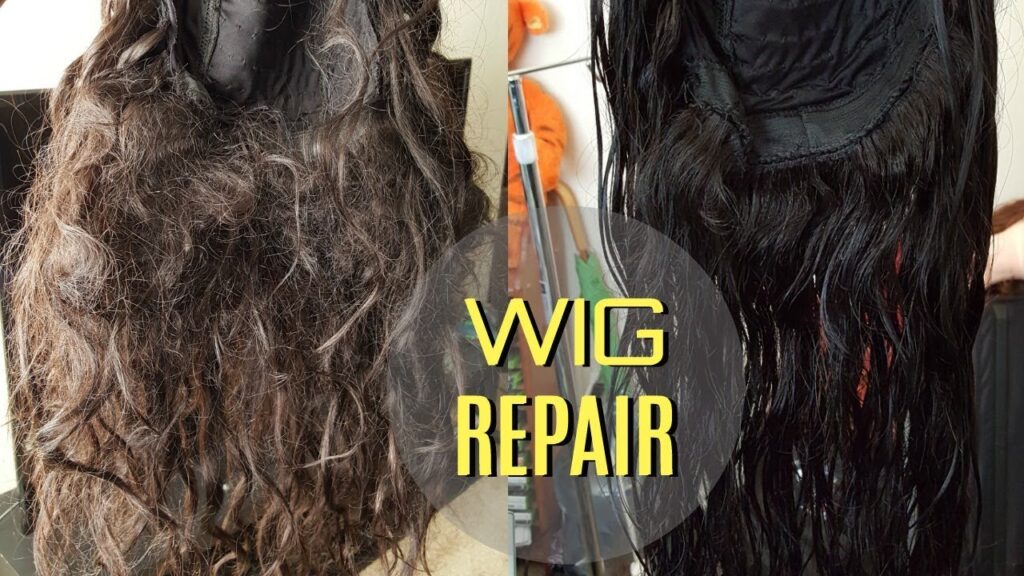
Professional Maintenance
Consider professional deep cleaning and styling services
While regular maintenance can keep your human hair wig in good condition, professional deep cleaning and styling services can help to revitalize and rejuvenate the hair. Consider scheduling a professional maintenance appointment every few months to ensure your wig receives the expert care it needs. Professional deep cleaning removes buildup and restores shine, while styling services can help to create new looks without causing damage or tangling.
Consult a stylist for specialized wig care advice
If you have specific concerns or questions about caring for your human hair wig, it’s always a good idea to consult a professional stylist. They can provide personalized advice and recommendations based on your wig’s type, texture, and length. A stylist can also help troubleshoot any tangling or maintenance issues you may be experiencing.
Get the wig re-adjusted or re-fit if needed
Over time, the fit of your human hair wig may become loose or uncomfortable. This can lead to increased tangling, as the wig moves and shifts more easily. If you notice that your wig is not fitting properly, consider getting it re-adjusted or re-fit by a professional. This ensures a snug and secure fit, minimizing the risk of tangling.
Have the wig professionally repaired for any damages
If your human hair wig sustains any damage, such as split ends, bald spots, or loose wefts, it’s best to have it professionally repaired. Attempting to fix the damage yourself can lead to further issues and tangling. A professional can restore the wig to its original condition and make any necessary repairs to prevent tangling and ensure longevity.
Follow the guidance of a wig professional for optimal care
Ultimately, the best way to keep your human hair wig from tangling is to follow the guidance of a wig professional. They have the knowledge and expertise to provide you with the best care routines and maintenance tips specific to your wig. Listen to their advice and ask questions to ensure you’re giving your wig the care it needs to stay tangle-free.
Avoiding Tangling During Physical Activities
Secure the wig with clips, pins, or a wig cap during exercise
Physical activities such as exercise can cause your human hair wig to move around and tangle. To prevent this, secure the wig in place using clips, pins, or a wig cap. This helps to keep the wig secure and minimize movement, reducing the risk of tangling.
Avoid excessive sweating by using a sweatband or head covering
Excessive sweating can lead to tangling in your human hair wig, as the moisture can cause the hair to swell and tangle. To avoid this, use a sweatband or head covering during intense physical activities to absorb sweat and keep the wig dry.
Tie back or braid longer wigs to minimize movement
If you have a longer human hair wig, tying it back or braiding it before physical activities can help to minimize movement and tangling. Secure the hair at the nape of your neck or create a loose braid to keep the wig in place and reduce the risk of tangling.
Use a wig grip or adhesive tape if necessary
If your human hair wig tends to move or slide during physical activities, consider using a wig grip or adhesive tape to keep it in place. Wig grips are specially designed bands that hold the wig securely against your scalp, preventing it from shifting or tangling. Adhesive tape can also be used to secure the wig along the hairline.
Clean the wig after intense physical activities
After intense physical activities, make sure to clean your human hair wig to remove sweat and debris that can contribute to tangling. Use a gentle shampoo and lukewarm water to wash the wig, focusing on the areas that are prone to sweat buildup. Allow the wig to air dry thoroughly before wearing it again.
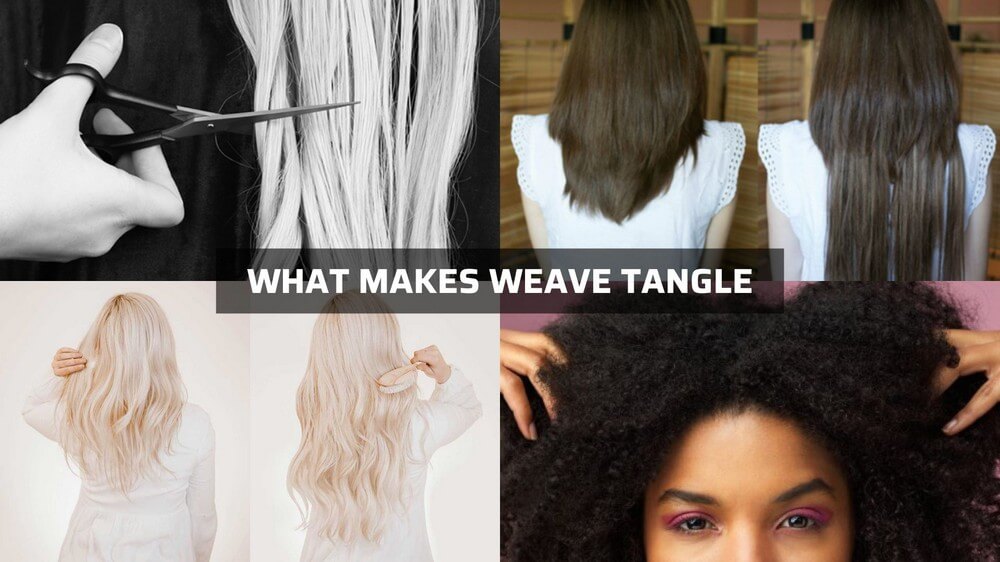
Choosing the Right Wig
Consider the quality and origin of the human hair
When choosing a human hair wig, it’s important to consider the quality and origin of the hair. Opt for wigs made from high-quality human hair, as they are less prone to tangling and offer better longevity. The origin of the hair can also affect its texture and quality, so choose a type that matches your natural hair or desired look.
Select the right wig cap construction for your needs
Human hair wigs come in various cap constructions, each offering different features and benefits. Consider your lifestyle and preferences when selecting the right wig cap construction. Options include lace front, full lace, monofilament, and hand-tied caps, among others. Each type provides different levels of comfort, breathability, and realism.
Match the wig texture to your natural hair for a seamless look
To achieve a seamless look, it’s important to match the texture of the wig to your natural hair as closely as possible. Consider factors such as straight, wavy, curly, or coily when choosing a wig, and select a texture that is similar to your own hair if you plan to blend the wig with your natural hair.
Choose the appropriate length and style for your desired look
When selecting a human hair wig, choose the length and style that align with your desired look. Keep in mind that longer wigs may require more maintenance and care to prevent tangling, as they have more hair. If you’re new to wearing wigs, consider starting with a shorter length to get accustomed to the maintenance routine.
Consult with a wig specialist for personalized guidance
If you’re unsure about which human hair wig to choose or need personalized guidance, it’s best to consult with a wig specialist. They can assess your needs, preferences, and budget, and recommend the best options for you. A specialist can also provide styling advice, wig care tips, and answer any questions you may have.
Common Mistakes to Avoid
Neglecting regular maintenance and care routines
Neglecting regular maintenance and care routines is one of the most common mistakes wig wearers make. To prevent tangling, it’s crucial to follow a consistent care routine, including washing, conditioning, and detangling. Regular maintenance ensures that your human hair wig stays in optimal condition and minimizes the risk of tangling.
Using harsh or incorrect hair care products on the wig
Using harsh or incorrect hair care products on your human hair wig can cause damage and tangling. Avoid using regular shampoos, conditioners, or styling products, as they may contain chemicals that can strip the hair of its natural moisture or leave residue. Instead, use products specifically formulated for wigs to keep them looking their best.
Skipping the detangling process before washing
Skipping the detangling process before washing your human hair wig is a common mistake that can lead to severe tangling. Always take the time to brush or comb through the wig before washing to remove any knots or tangles. This ensures that the hair is free of tangles and makes the washing process more manageable.
Exposing the wig to extreme temperatures or weather conditions
Exposing your human hair wig to extreme temperatures or weather conditions can cause tangling and damage. Avoid exposing your wig to excessive heat, cold, sunlight, or humidity, as these can affect the integrity of the hair and lead to tangling. When in doubt, protect your wig by wearing a hat or scarf and seek shade when necessary.
Not seeking professional advice for complex wig care needs
If you have complex wig care needs or specific concerns, it’s important to seek professional advice. A human hair wig specialist or stylist can provide personalized guidance and recommend the best care routines and products for your wig. They can address any issues you may be facing and help you prevent tangling.
Long-Term Wig Care
Consider periodic wig conditioning treatments
In addition to regular shampooing and conditioning, periodic wig conditioning treatments can help to keep your human hair wig in optimal condition. Deep conditioning treatments, leave-in conditioners, or hair masks can provide extra moisture and nourishment, keeping the hair soft, smooth, and less prone to tangling. Follow the manufacturer’s instructions or consult a professional for the best treatment options for your wig.
Store the wig in a cool, dry place away from direct sunlight
Proper storage is essential for long-term wig care. When you’re not wearing your human hair wig, store it in a cool, dry place away from direct sunlight. Excessive heat or sunlight can cause the hair to become dry and prone to tangling. Consider using a wig stand or a mannequin head to maintain the shape and prevent tangling during storage.
Avoid brushing or styling the wig excessively
While it’s important to maintain your human hair wig, excessive brushing or styling can lead to tangling and damage. Avoid brushing or styling the wig excessively, as this can cause unnecessary friction and stress on the hair. Instead, gently detangle and style the wig as needed, using minimal force and the appropriate tools.
Replace or repair damaged or worn-out wig parts
Over time, certain parts of your human hair wig may become damaged or worn-out, leading to tangling and an overall less-than-ideal appearance. If you notice any loose wefts, bald spots, or damaged lace, it’s essential to replace or repair these parts as soon as possible. This ensures that your wig stays in optimal condition and minimizes the risk of tangling.
Regularly assess the condition of the wig for potential issues
Regularly assessing the condition of your human hair wig is crucial for preventing tangling and detecting any potential issues early on. Check for signs of damage, such as split ends, loose strands, or bald spots, and address them promptly. Regular maintenance and care routines, combined with thorough inspections, help to keep your wig in optimal condition.
Wig Cap Maintenance
Clean the wig cap regularly to remove sweat and oils
Regularly cleaning the wig cap is essential for maintaining a clean and fresh wig. Sweat and oils can accumulate on the cap, leading to odor and potential tangling. Follow the manufacturer’s instructions for cleaning the cap, and use a gentle shampoo or wig cap cleaner to remove sweat and oils. Rinse thoroughly and allow the cap to air dry before wearing the wig again.
Replace worn-out or stretched wig caps
Over time, the wig cap may become worn-out or stretched, resulting in a loose or uncomfortable fit. This can cause tangling, as the wig moves and shifts more easily. It’s important to replace the wig cap as needed to ensure a snug and secure fit. Look for signs of wear, such as fraying edges or stretched elastic, and replace the cap when necessary.
Adjust the wig cap for a snug and secure fit
To prevent tangling, it’s important to ensure that your human hair wig is properly fitted and secure on your head. Adjust the wig cap to achieve a snug fit, making sure it’s not too tight or too loose. This helps to minimize movement and reduce the risk of tangling during wear.
Invest in a high-quality wig cap for added comfort
A high-quality wig cap can provide added comfort and prevent tangling. Look for wig caps made from breathable and lightweight materials, such as nylon or mesh. These caps allow the scalp to breathe and reduce sweating, minimizing the risk of tangling and discomfort.
Consider using wig liners or cushions for added comfort
If you find that your human hair wig is causing discomfort or irritation, consider using wig liners or cushions. These are soft and breathable accessories that can be worn underneath the wig cap to provide extra comfort and reduce friction. They help to prevent tangling by creating a barrier between the cap and your scalp.
Removing Tangles
Apply a leave-in conditioner or detangling spray to the tangles
When you encounter tangles in your human hair wig, apply a small amount of leave-in conditioner or detangling spray to the affected areas. These products help to soften the hair and make it easier to comb through the tangles. Spray or apply the product directly to the knots and gently work through them with your fingers or a wide-tooth comb.
Gently work through the tangles with your fingers or a comb
When removing tangles from your human hair wig, be gentle and patient. Use your fingers or a wide-tooth comb to slowly and carefully work through the knots. Start from the ends and slowly work your way up to the roots, applying light pressure and using a gentle back-and-forth motion. Avoid pulling or tugging on the tangles, as this can cause breakage and further tangling.
Avoid using excessive force or pulling on the tangles
It’s crucial to avoid using excessive force or pulling on the tangles when removing them from your human hair wig. Pulling too hard can cause the hair to break or become even more tangled. Instead, take your time and be patient. Apply a small amount of product, gently work through the tangles, and detangle a few strands at a time.
Consider using a wig detangling brush for more stubborn tangles
If you encounter stubborn tangles or knots in your human hair wig, consider using a wig detangling brush. These brushes are specifically designed to remove tangles from wigs without causing damage or breakage. The soft bristles and flexible design help to gently work through knots, reducing the risk of tangling.
Regularly detangle the wig to prevent severe tangling
To prevent severe tangling in your human hair wig, make it a habit to regularly detangle the hair. Set aside time every week or every few days to gently comb through the wig, starting from the ends and working your way up. This helps to prevent the formation of severe tangles and makes the detangling process easier and more manageable.
Conclusion
Proper care and maintenance are crucial for preventing tangling in human hair wigs. By following preventive measures, regular cleaning and detangling routines, and adopting good habits, you can keep your human hair wig tangle-free and looking beautiful for a long time. Choosing the right wig, seeking professional advice when needed, and avoiding common mistakes also contribute to wig longevity and optimal performance. By investing in quality products, practicing good maintenance, and following the advice of wig professionals, you can enjoy hassle-free wig wearing experiences and endless style possibilities, all without the frustration of tangling. With the right care, your human hair wig will continue to be a valuable and treasured accessory in your hair collection.
